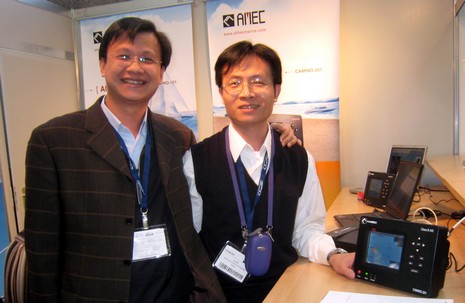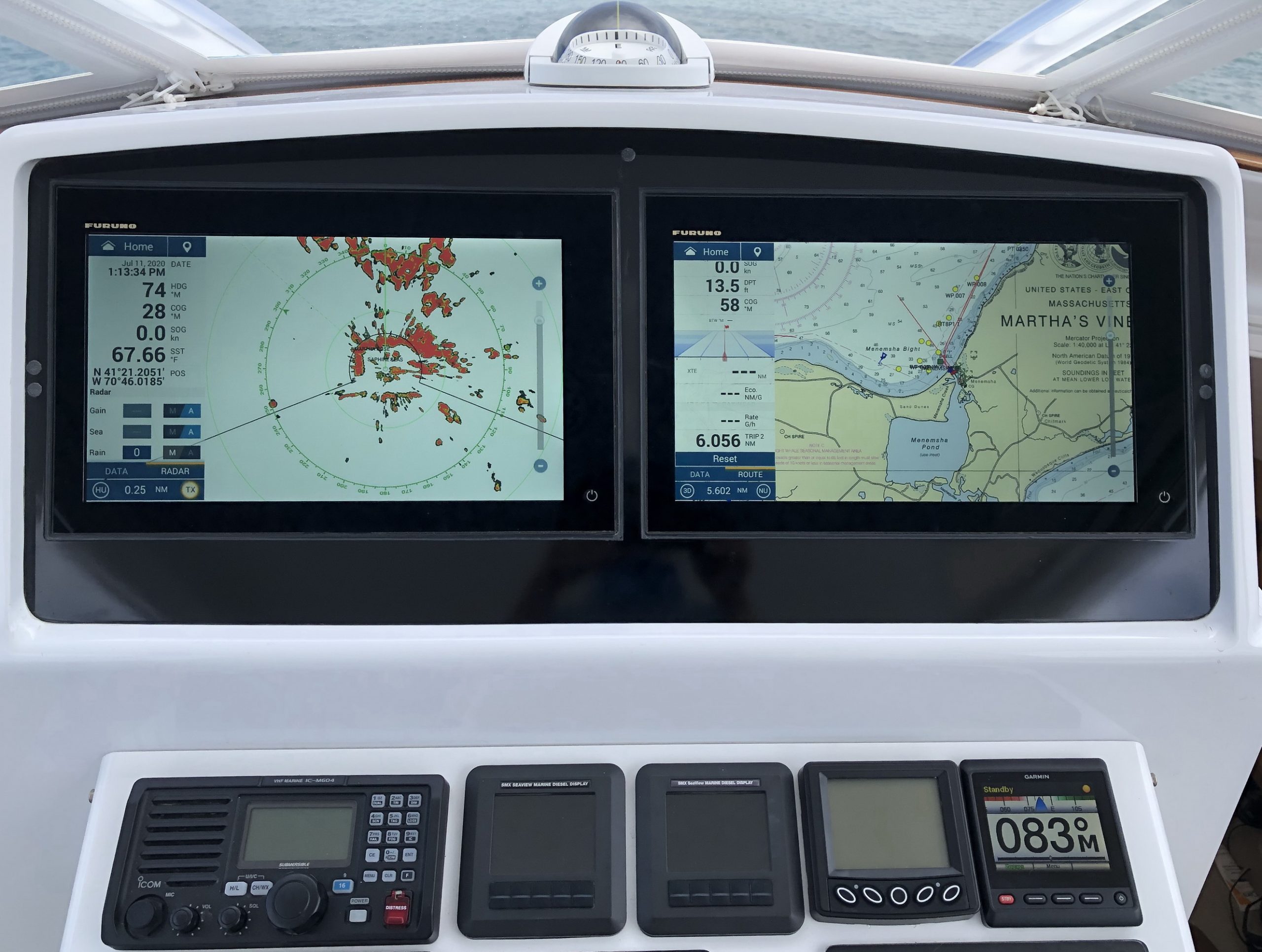Alltek engineering, “exactly like!”

That’s Charlie Hsu, sales & marketing guy for Alltek Marine Electronics Corp. (AMEC), along with the company’s chief engineer. They were at METS looking for companies interested in distributing their Class B AIS, mentioned here last April. When showing me the unit, Hsu pointed out some yellow colored targets and explained that they were “buddy” boats.
“Oh, you mean like the Simrad AI50’s buddy feature?” said I.
“Exactly like that!,” replied Hsu, laughing.
Then he showed me a new MOB product Alltek is working on, seen below (with the AIS display used to plot MOBs).
Of course I said “Oh, you mean like Raymarine’s LifeTag system?”
“Exactly like!” answered a proud Mr. Hsu.
Actually there are differences between AMEC brand products and the devices they emulate. The box, for instance, has Bluetooth built in, which is used to broadcast AIS data, and is also used by the MOB tags. But I found it refreshing how frank Charlie Hsu is about copying good ideas from other companies. Why not? (Patents not withstanding, of course, but I don’t think obvious ideas should be patentable.) Sometimes I think Western companies get hung up on making things new and different, just for the sake of different. Sometimes emulating a good feature from a competitor is the best way to go.















Ben.. Is anyone making/marketing a class B AIS that broadcasts just my position and pertinent data? This will be an ongoing question, and I appreciate you passing on what you find out. I use Coastal Explorer on my PC to follow the deep drafts, tugs, and most ferries. I want to let them know where I am.
Hope your Thanksgiving was as good as mine, now back to the exercise bike and my diet, gag.
Patrick Harman
One thing that you need to be certain to explain about the lifetag system (or this clone) is that it does not “track” the person overboard. The maximum range of the unit is 32 feet. All that it does is virtually push the “MOB” button on your chartplotter when the signal is lost. Useful, but I think that people might get a false sense of security from the wristbands. If you fall overboard, you may as well discard the wristband along with your shoes.
I think that one would be taking a big chance relying on a small Asian firm for life safety devices. (Have you looked at their manual online? Chinglish in extreme.) They are smart guys, but I doubt that they have the design, test, or quality assurance resources of the majors. (If it doesn’t work, who do you sue?)
You’re right, George, LifeTag is what some term a proactive MOB system, but it is not an active system. I think that’s all explained in my testing, linked to above.
Patrick, all the other Class B transponders about to be approved here in the States do not have their own screen and are less expensive than the Simrad AI50. I’m particularly fond of the ACR Nauticast B, which I tested in June. It will retail for about $1,100 complete with antennas.
Software Radio Technology, which makes the circuit board used in all the Class B’s waiting approval (except possibly Alltek’s), says it’s working on a smaller, cheaper 2nd generation.
This company is in Taiwan … home to many innovative engineers. I suspect in getting their ISO-9001 certification early in the life of their company, they are aware and prepared to overcome many challanges in bringing a product to the US.
A follow up from Charlie Hsu (and apologies to him if I misunderstood some of what he told me at METS):
Thanks for your interest on Alltek Marine; as for your comments of “Alltek engineering, “exactly like!” posted on 23rd November, I would like to brief you more on our company background and product rollout to give you further insights on AMEC.
Prior to AMEC, our RD team has served in national defense field for over 20 years and the expertise covers military radar, missile and other related precision controlling and monitoring. Accordingly, for the questioning on emulating “Buddy-Tracking” from SIMRAD is a miscommunication; as a matter of fact, the “Friend Ship Tracking” on AMEC AIS was essentially inspired by ARPA radar to monitor dynamic targets and alert while specific targets come out on the sea; and we had received the exact request and the requests on other more advanced functions from many users at Shanghai International Boat Show on 5th of April, 2007. Moreover, we have planed to develop series of safety and emergency prevention related features onto our Class B AIS, such as MOB rescue aids and anchor drifting …etc.
As an innovative and inventive new comer in the filed, AMEC intends to include the best possible ideas we can imagine to ensure a safe and enjoyable journey to our customers. For instance, AMEC was the very first to integrate display and Bluetooth onto Class B AIS (April, 2007) to enable users with better viewing and free from cabling; secondly, AMEC is the first one to launch Chinese version Class B AIS. Thirdly, AMEC may be one of the few non-SRT AIS mature solution providers in the worldwide and capable of satisfying tailor-made requests from our clients.
On the other hand, AMEC MOB is much different from Raymarine LifeTag. The major differences include 1) we apply Bluetooth technology and Raymarine uses Zigbee instead; 2) we combine MOB together with AIS system which is also first to the world; the idea originated from our safety commitment to our clients; 3) in addition, we add high brightness white LED indicator to ensure easier identification on the dark sea.
Though a new player in maritime equipment industry, AMEC commits to provide our clients with the safe and enjoyable journey with the best efforts. Again, thanks for giving AMEC the great opportunity to clarify the misunderstandings and re-emphasize our major differences. Please feel free to contact me if any further questions on AMEC products.
What is the battery life of their version of lifetag? Bluetooth is a bit of a battery hog compared to Zigbee.
I guess my questions and comments to Mr Hsu would be what are the differences to the end user experience? The underlying technology may be interesting to know (Zigbee vs. BT), however this sounds pretty similar to the capabilities of the Ray E-system with the LifeTag. It will display my AIS info on the same screen as the MOB info. It doesn’t do tracking other than “somebody’s gone!?!” and it happened when the boat was “here”. Is there some specific functionality that gives value added to this product integration with AIS? Just adding it to a screen doesn’t make it unique. I do like the idea of the LED on the device.
Bluetooth is a stable solution for short range communication, though it consumes more power than Zigbee; the good news is the ultra low power Bluetooth is to launch in the coming year, and we will integrate it into our product soon.
We provide directional aid on AIS display to shorten the time to rescue crew member; and a different icon helps boater to recognize the situation of MOB or active SOS.
Moreover, a new function (under lab testing now, still a top secret) is to launch soon: a certain switch on the boat will be initiated while AIS station lose connection with any pendant. This unique function will signifcantly shorten the time to rescue.
Hi Ben,
You may rememebr we e-mailed some time back about the Sea Safe beacon that works both as a Man Overboard alert and as a trackable floating beacon.
The beacon works once wet or the user pushes a button on the side, and battery life of the unit once wet or switched to track mode is about 7 days.
We had a few problems with sealing on the units to start with, they are fine on the surface, but they are designed for divers as well so they need to withstand 120 ft or 40 metres deep so we are still sorting that one out.
I will keep you posted as to the availablity of these from New Zealand, and if AIS is anything to go by, it will take a long while before we start getting units aproved by the FCC for use in the States.
The Units do pass the apropiate standards here and where they are made though, so it shouldn’t be a biggie.
The video on our website shows the older reciever that first was tested, now the newer reciever is slim and stlyish, and more importantly, water proof.
Kind Regards,
Michael.